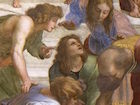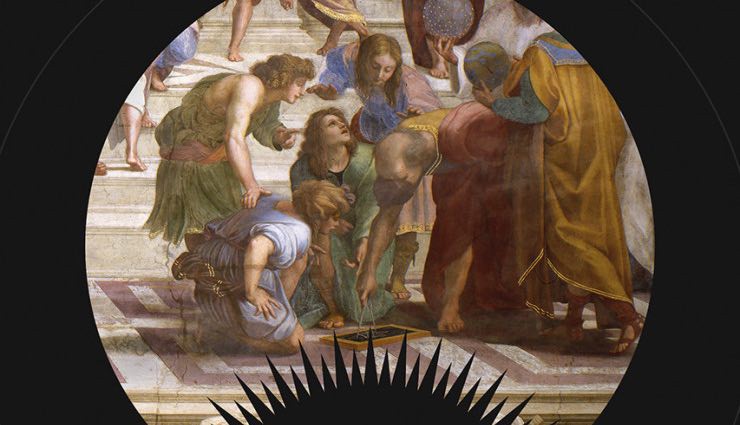Welcome back to the Tor.com eBook Club! August’s pick is The Just City, the first book in Jo Walton‘s Thessaly trilogy. Join in below, as Jo discusses one of the inspirations behind her characterization of Apollo.
One of the points of view of all three Thessaly books is Apollo. Writing a god’s point of view is literally hubris, though the Greeks did it all the time in poetry and drama. Apollo is the only narrator who stays with us through the trilogy, the one who ties it all together. His voice, his sly snarky voice, and his experience of being a god taking on mortal life for the duration of the experiment, are one of the things that made this project really interesting for me. This part of the books had a much more direct inspiration than most of my ideas. It came from a baroque statue.
In the summer of 2011, Ada Palmer took me to the Borghese museum in Rome without warning me at all. She knew the Berninis would make my head explode, but she didn’t give me any foreshadowing, she just took me there and let it happen. It would be a museum worth going to anyway, it has a Botticelli and a Raphael and some lovely Roman sculpture. But what makes it wonderful are the three stunning statues by Bernini (1598-1680), all of which do things with marble that you wouldn’t imagine were possible, both technically and narratively. There’s the Aeneas, where you have Anchises carried on Aeneas’s shoulders from the wreck of Troy, with Ascanius behind—the young boy, the strong man, and the old man, all together, and Anchises clutching the statue of the lars and penates of Troy in his hand. The amazing thing is that the statue he’s holding is made out of marble—well, the whole thing is made out of one block of marble, but Bernini distinguishes the texture of the flesh and cloth so much that though the stone hand is holding a stone statue they’re completely different substances. You have to see it. Photographs won’t do it.
Warning—discussion of consent issues.
Bernini’s other two masterpieces in the Borghese are related—they’re both about rape. There’s Hades and Proserpina, and there’s Apollo and Daphne, and they’re both saying something interesting and currently relevant to the debate about rape culture that’s going on today. They made me realise that every single other instance of “rapes of the gods” I’d seen was the male gaze, was all about “I’d like to do her!” Bernini’s sculptures are from the women’s point of view, and all about the “Do not want!” The Hades and Proserpina is particularly disturbing. But it was the Apollo and Daphne that really got to me. For one thing, it’s one of the most beautiful sculptures I’ve ever seen. It’s technically quite amazing. And then narratively, it conveys time so well—it’s capturing the moment at which Daphne is in the middle of turning into a tree. And Apollo is right there, and he’s completely oblivious, his beautiful face, serene, he has no idea he’s doing anything wrong (unlike horrible Hades, who knows and doesn’t care at all) and the statue has so much narrative and so much time but it’s still and frozen, and yet, if he were moving then in another second he’d be smacked in the groin by a tree branch.
I couldn’t help wondering what happened next. Would he learn from that branch in the groin? Could he learn from it? What would he learn from it? Was he capable of understanding it? Who could help him understand? If you look back at Ovid, which would have been where, ultimately, Bernini got the story, then the end result of Apollo’s interaction with Daphne, after he attempts to rape her and she turns into a tree, is that he adopts the tree as his sacred laurel that poets crown themselves with. What does that mean, in context? Is that the closest he can come to making amends, or is it the closest he can come to claiming the tree? It really could be either.
People say there are only three plots, and one of them is supposed to be “man learns lesson”. “God learns lesson” is a much less common variant, but it fascinated me. As I walked round and round the statue, looking at it from every angle until we got thrown out of the museum, I kept thinking about time and consent and Apollo, all of which eventually came to be major themes of the novels. I also kept thinking “He’s always been so nice to me!” which is what people think when they hear about their friends doing bad things to other people.
Apollo’s voice, the voice I use in the books, the voice that says “She turned into a tree. It was a Mystery. It must have been because I didn’t understand it. I hate not understanding a thing!” came to me as I was walking around Bernini’s statue. Clueless about some things, but not unwilling to learn, funny and snarky and immensely powerful and entitled—but prepared to become vulnerable to become better. I’ve always been interested in writing about why good people do bad things. It’s what my Small Change books are directly about.

I didn’t mean to write a book about consent. But once I saw that Plato’s Republic and snarky Apollo could fit together, I saw all the ways it could explore that, the freedom of the children rescued and brought to the city, the robots who nobody guessed were intelligent, the expectations that Plato put on the generations, and the dynamic of sexism that Plato sort of saw beyond. In the first book I set out to bring a lot of this together, and I used my other points of view, Simmea, the girl who really is perfectly fitted for the Republic, and Maia, the woman who escaped from the Victorian era where she couldn’t have a life of the mind and ended up in the Republic with a lot of things she didn’t choose.
But one starting point was a four hundred year old statue, illustrating a two thousand year old poem, and the questions Bernini was using that narrative to explore.
Jo Walton is a science fiction and fantasy writer. She’s published a collection of Tor.com pieces, three poetry collections and thirteen novels, including the Hugo and Nebula winning Among Others. Her most recent book is Necessity. She reads a lot, and blogs about it here from time to time. She comes from Wales but lives in Montreal where the food and books are more varied.
 Jo Walton is a science fiction and fantasy writer. She’s published a collection of Tor.com pieces, three poetry collections and thirteen novels, including the Hugo and Nebula winning Among Others. Her most recent book is Necessity. She reads a lot, and blogs about it here from time to time. She comes from Wales but lives in Montreal where the food and books are more varied.
Jo Walton is a science fiction and fantasy writer. She’s published a collection of Tor.com pieces, three poetry collections and thirteen novels, including the Hugo and Nebula winning Among Others. Her most recent book is Necessity. She reads a lot, and blogs about it here from time to time. She comes from Wales but lives in Montreal where the food and books are more varied.










